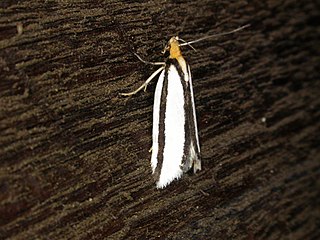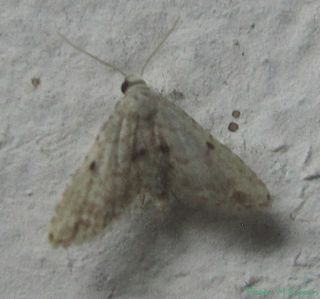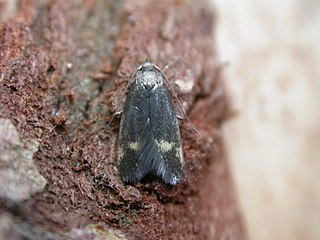| Illidgea | |
|---|---|
| Scientific classification | |
| Kingdom: | |
| Phylum: | |
| Class: | |
| Order: | |
| Family: | |
| Genus: | Illidgea |
| Type species | |
| Cryptophaga epigramma Meyrick, 1890 [2] | |

Illidgea is a genus of moths of the family Xyloryctidae. [3]
| Illidgea | |
|---|---|
| Scientific classification | |
| Kingdom: | |
| Phylum: | |
| Class: | |
| Order: | |
| Family: | |
| Genus: | Illidgea |
| Type species | |
| Cryptophaga epigramma Meyrick, 1890 [2] | |

Illidgea is a genus of moths of the family Xyloryctidae. [3]

Xylorycta is a genus of moths of the family Xyloryctidae. Xylorycta species are found in Africa and Australia and are strongly associated with the plant family Proteaceae, being found on Hakea, Lambertia, Grevillea, Leptospermum, Macadamia, Oreocallis, Persoonia and Telopea. The larvae of some species bore into stems or branches, or the flower spikes of Banksia, but most live in a silk gallery spun in the foliage.
Araeomorpha is a genus of moths of the family Crambidae.

Araeopteron is a genus of moths of the family Erebidae. The genus was erected by George Hampson in 1893.

The Depressariinae – sometimes spelled "Depressiinae" in error – are a subfamily of moths in the superfamily Gelechioidea. Like their relatives therein, their exact relationships are not yet very well resolved. It has been considered part of family Elachistidae sensu lato or included in an expanded Oecophoridae. In modern classifications they are treated as the distinct gelechioid family Depressariidae.

Borkhausenia is a genus of the concealer moth family (Oecophoridae) described by Jacob Hübner in 1825. Among these, it belongs to subfamily Oecophorinae, wherein it is probably closely related to Hofmannophila. In the past, several other Oecophoridae have been included in Borkhausenia, as well as a few even more distant members of the superfamily Gelechioidea. Metalampra was originally described as a subgenus of Borkhausenia. Telechrysis has also been included here as a subgenus by some, while other authors have considered it a separate genus in the Oecophorinae or – if these are also considered distinct – the Amphisbatinae.

Xyloryctidae is a family of moths contained within the superfamily Gelechioidea described by Edward Meyrick in 1890. Most genera are found in the Indo-Australian region. While many of these moths are tiny, some members of the family grow to a wingspan of up to 66 mm, making them giants among the micromoths.

Pedois is a genus of moths of the family Depressariidae.

Cryptophasa is a genus of moths of the family Xyloryctidae.
Chalarotona intabescens is a moth in the family Xyloryctidae. It was described by Edward Meyrick in 1890. It is found in Australia, where it has been recorded from New South Wales and Queensland.

Plectophila is a genus of moths of the family Xyloryctidae.
Compsotorna oligarchica is a moth in the family Xyloryctidae. It was described by Edward Meyrick in 1890. It is found in Australia, where it has been recorded from New South Wales and Queensland.
Cryptophasa epadelpha is a moth in the family Xyloryctidae. It was described by Edward Meyrick in 1890. It is found in Australia, where it has been recorded from New South Wales and Queensland.
Illidgea aethalodes is a moth in the family Xyloryctidae. It was described by Alfred Jefferis Turner in 1902. It is found in Australia, where it has been recorded from the Northern Territory and Queensland.
Illidgea epigramma is a moth in the family Xyloryctidae. It was described by Edward Meyrick in 1890. It is found in Australia, where it has been recorded from the Australian Capital Territory, New South Wales, Queensland and South Australia.
Pilostibes embroneta is a moth in the family Xyloryctidae. It was described by Alfred Jefferis Turner in 1902. It is found in Australia, where it has been recorded from Queensland.
Xylorycta orectis is a moth in the family Xyloryctidae. It was described by Edward Meyrick in 1890. It is found in Australia, where it has been recorded from New South Wales, the Northern Territory, Queensland and Western Australia.
Xylorycta micracma is a moth in the family Xyloryctidae. It was described by Edward Meyrick in 1890. It is found in Australia, where it has been recorded from New South Wales, Queensland and Tasmania.
Peritornenta thyellia is a moth in the family Depressariidae. It was described by Edward Meyrick in 1902. It is found in Australia, where it has been recorded from Queensland and New South Wales.
Phylomictis eclecta is a moth in the family Depressariidae. It was described by Alfred Jefferis Turner in 1906. It is found in Australia, where it has been recorded from Queensland.
Phylomictis leucopelta is a moth in the family Depressariidae. It was described by Oswald Bertram Lower in 1902. It is found in Australia, where it has been recorded from South Australia.